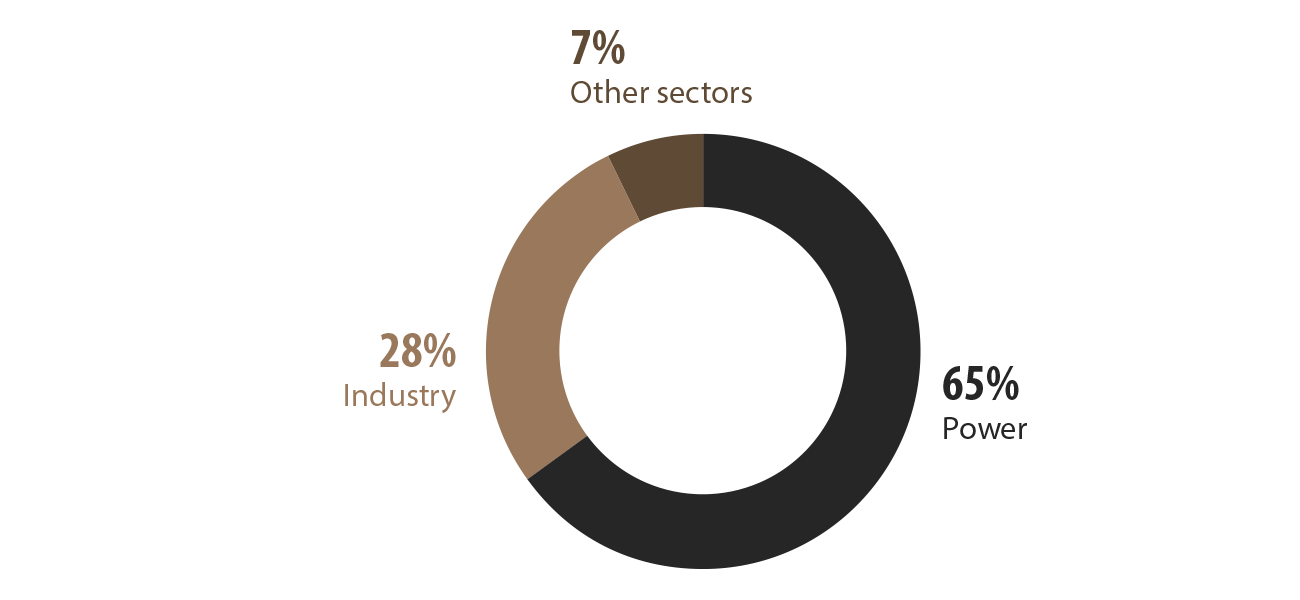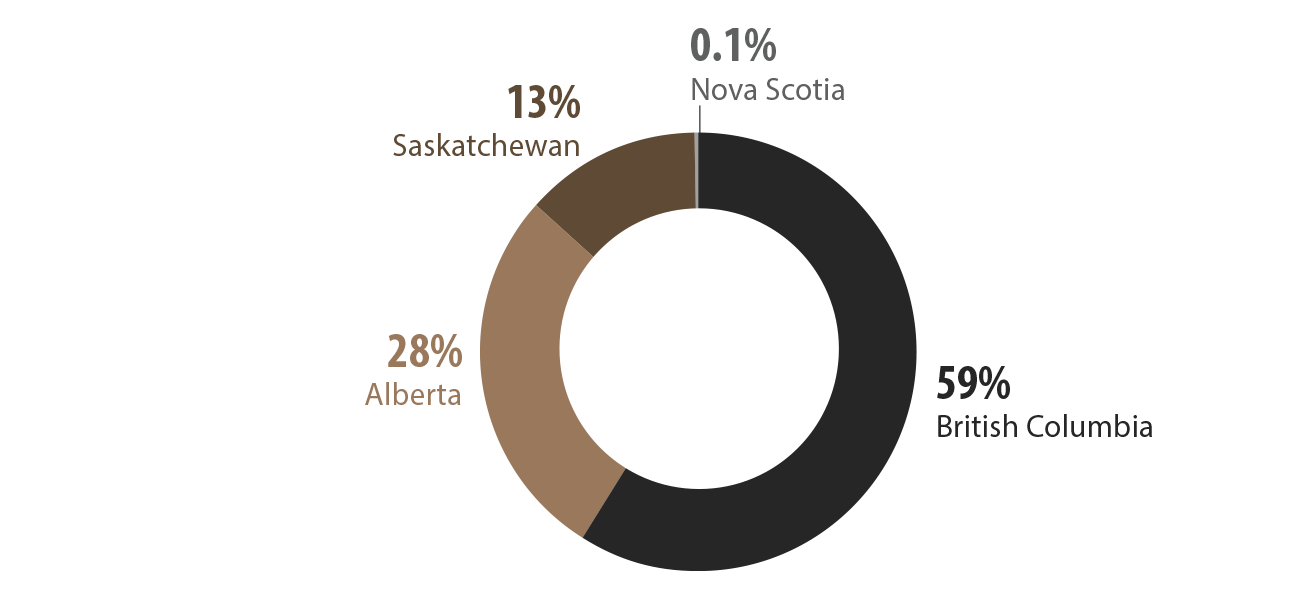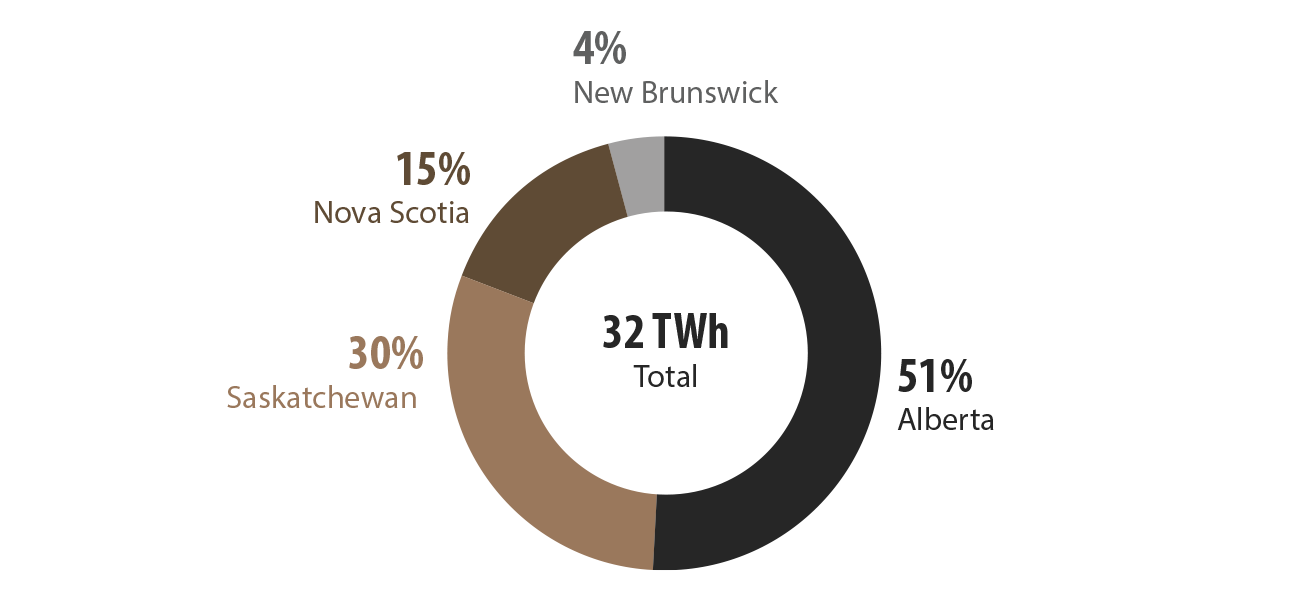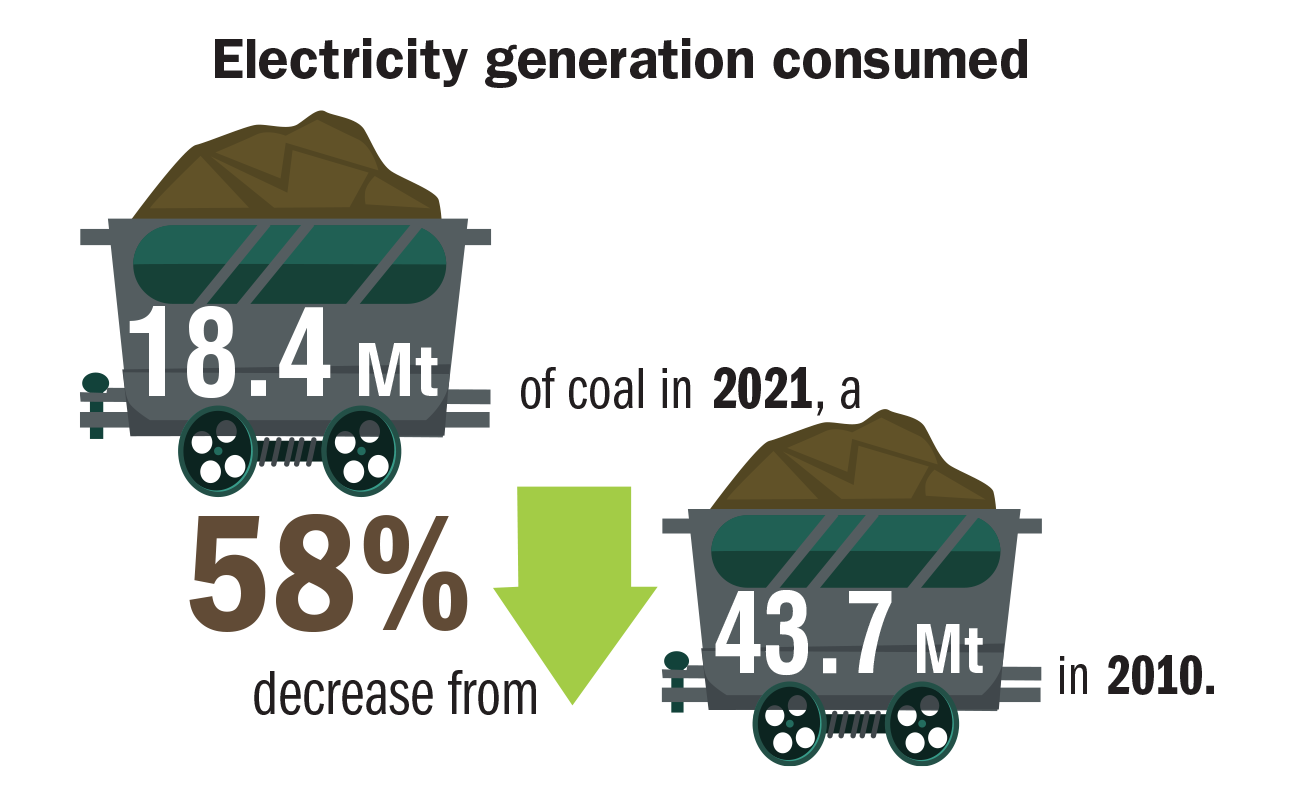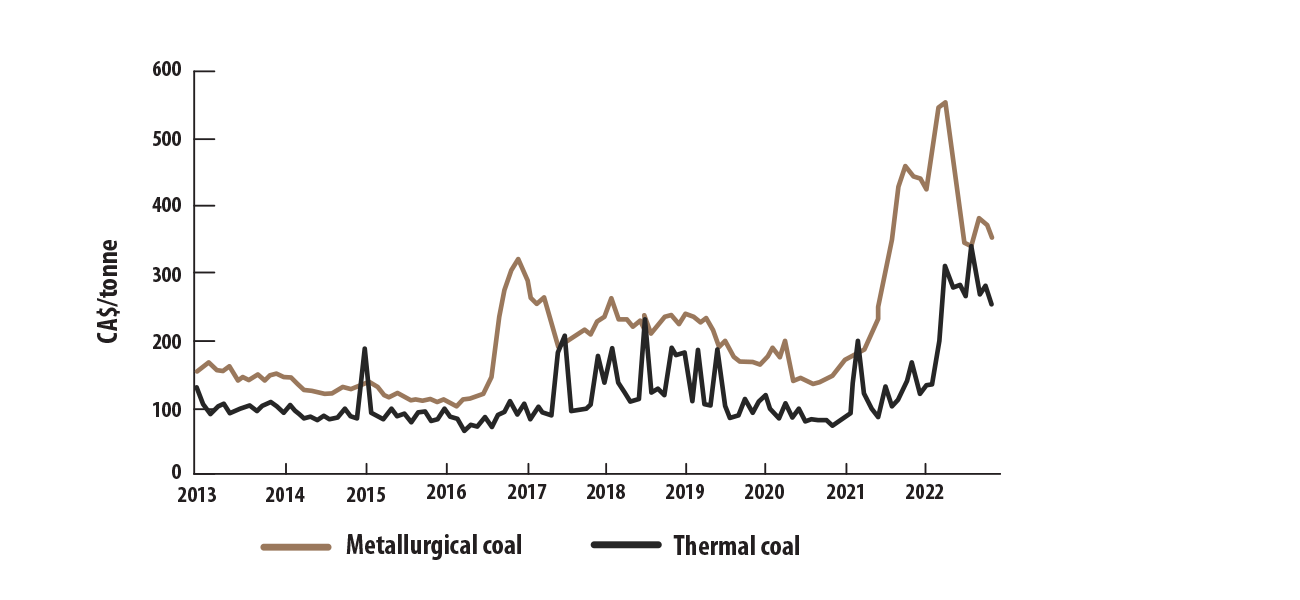Coal facts

Coal is an organically derived material formed from the remains of decayed plant material that were compacted into a solid form through millions of years of chemical changes, pressure and heat.
The rich carbon content of coal gives it most of its energy, which is released as heat when burned in the presence of air or oxygen. This energy can then be converted into other forms of useful energy, such as electricity. Coal used for electricity generation is commonly referred to as thermal coal. Higher carbon and lower moisture coal is often used to make steel. Coal used for steelmaking is commonly referred to as metallurgical or coking coal.
Key facts
- Coal is used mostly for generating electricity, however, notable amounts are also used for manufacturing steel.
- Canadian mines produced 47 million tonnes of coal in 2022, 59% of which was metallurgical coal.
- Canada’s coal production decreased by 32% over the past decade, with thermal coal accounting for almost three quarters of the decline.
- Most of the coal mined in Canada comes from British Columbia (59%), Alberta (28%) and Saskatchewan (13%).
- The Government of Canada is phasing out coal-fired electricity by 2030.
Learn more about coal
 Uses
Uses
Coal is used for generating electricity, manufacturing steel and cement, and for various industrial and residential applications.
Coal supplies just over a third of global electricity generation. In Canada, 5% of the electricity was generated with coal in 2021, consuming 18.4 Mt of coal, which is down 58% from 43.7 Mt in 2010.
The Government of Canada is phasing out coal-fired electricity by 2030. However, coal will continue to be used for metallurgical processes.
 Canadian production
Canadian production
Canada produced 46.7 Mt of coal in 2022, of which 59% was metallurgical coal used for manufacturing steel and 41% was thermal coal used for generating electricity.
Some power-generating companies not only use coal to generate electricity but they also own coal mines or are involved in coal production themselves. Other companies buy coal to generate electricity.
Canada’s coal production decreased by 32% over the past decade, with thermal coal accounting for three quarters of the decline.
Canadian coal production, 2013–2022 (p)
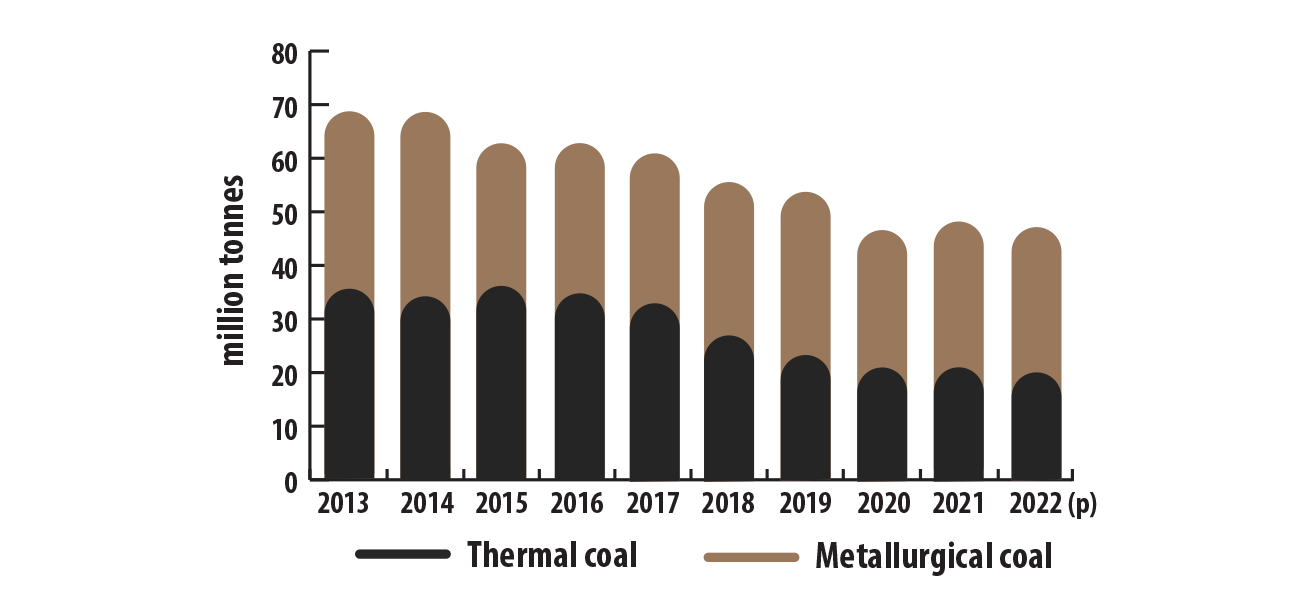
Text version
This bar chart shows Canada’s annual mine production of coal from 2013 to 2022. Total coal production was 68.4 million tonnes in 2013 but declined to a decade low of 46.1 million tonnes by 2020. It increased to 47.6 million tonnes in 2021 but decreased to 46.7 million tonnes in 2022.
Thermal coal production was estimated to be 35.4 million tonnes in 2013 and decreased to a decade low of 19.3 million tonnes in 2022.
Metallurgical coal production was estimated to be 33.1 million tonnes in 2013 and decreased to a decade low of 25.3 million tonnes in 2020. From 2021 to 2022, metallurgical coal production increased from 26.9 million tonnes to 27.4 million tonnes.
International context
Global coal production was estimated to be 8.4 billion tonnes in 2022, up 8% compared to 2021. The top five producing countries (China, India, Indonesia, the United States and Australia) accounted for 81% of the world's coal production.
World coal production, 2013–2022 (p)
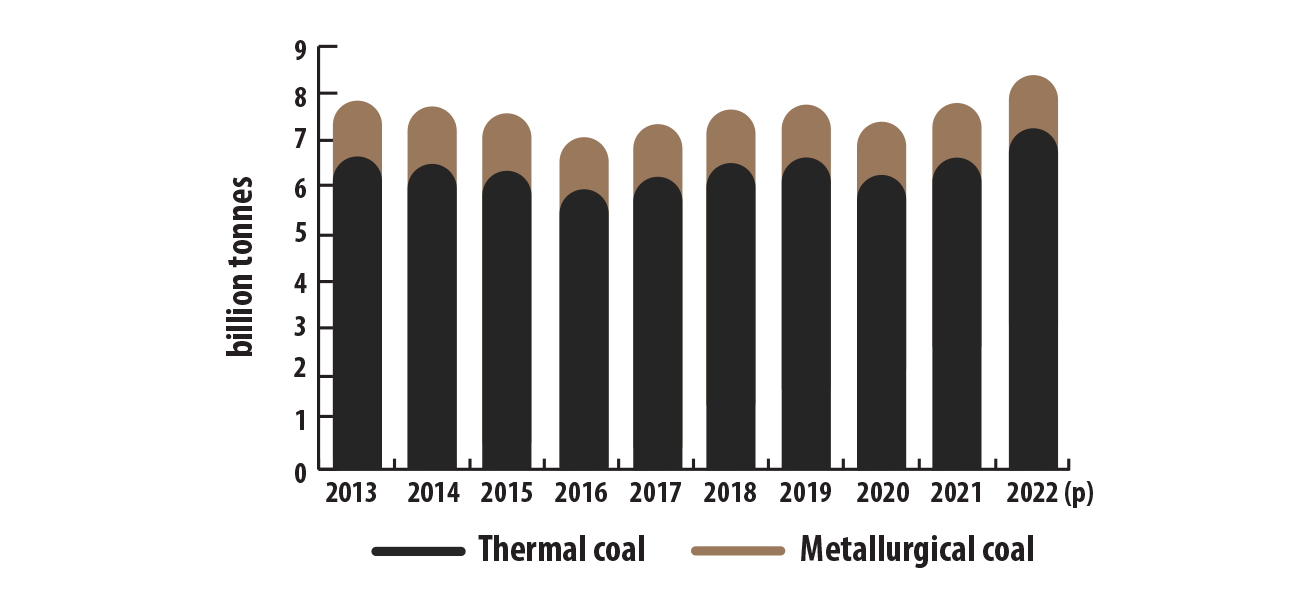
Text version
This bar chart shows the world's annual coal production from 2013 to 2022. In 2013, production was 7.8 billion tonnes. It gradually declined to 7.1 billion tonnes by 2016 but started to increase in 2017 and reached 7.7 billion tonnes in 2019. In 2020, production decreased to 7.4 billion tonnes, but increased to 7.8 and 8.4 billion tonnes in 2021 and 2022, respectively.
Thermal coal production was 6.6 billion tonnes in 2013 decreased to 6.0 billion tonnes in 2016, started to increase in 2017 and reached 6.6 billion tonnes in 2019. In 2020, thermal coal production decreased to 6.3 billion tonnes, but increased to 6.7 and 7.2 billion tonnes in 2021 and 2022, respectively.
In contrast, metallurgical coal production was 1.2 billion tonnes from 2013 to 2015 when it fell to 1.1 billion tonnes in 2016. From 2017 to 2022, metallurgical coal production remained stable at 1.1 billion tonnes.
See how Canada’s coal ranks on an international scale:
World production
| Rank | Country | Million tonnes | Percentage of total |
|---|---|---|---|
| 1 | China | 4,144 | 49.5% |
| 2 | India | 944 | 11.3% |
| 3 | Indonesia | 687 | 8.2% |
| 4 | United States | 539 | 6.4% |
| 5 | Australia | 458 | 5.5% |
| 14 | Canada | 47 | 0.6% |
| - | Other countries | 1,552 | 18.5% |
| - | Total | 8,371 | 100.0% |
| Rank | Country | Million tonnes | Percentage of total |
|---|---|---|---|
| 1 | China | 3,590 | 49.5% |
| 2 | India | 887 | 12.2% |
| 3 | Indonesia | 681 | 9.4% |
| 4 | United States | 482 | 6.6% |
| 5 | Russia | 311 | 4.3% |
| 16 | Canada | 19 | 0.3% |
| - | Other countries | 1,277 | 17.6% |
| - | Total | 7,245 | 100.0% |
| Rank | Country | Million tonnes | Percentage of total |
|---|---|---|---|
| 1 | China | 555 | 49.2% |
| 2 | Australia | 169 | 15.0% |
| 3 | Russia | 134 | 11.9% |
| 4 | India | 57 | 5.1% |
| 5 | United States | 57 | 5.1% |
| 6 | Viet Nam | 47 | 4.2% |
| 7 | Canada | 27 | 2.4% |
| - | Other countries | 80 | 7.1% |
| - | Total | 1,126 | 100.0% |
World exports
| Rank | Country | Million tonnes | Percentage of total |
| 1 | Indonesia | 471 | 34.1% |
| 2 | Australia | 359 | 26.0% |
| 3 | Russia | 210 | 15.2% |
| 4 | United States | 77 | 5.6% |
| 5 | South Africa | 68 | 4.9% |
| 6 | Colombia | 56 | 4.1% |
| 7 | Canada | 36 | 2.6% |
| - | Other countries | 102 | 7.4% |
| - | Total | 1,380 | 100.0% |
| Rank | Country | Million tonnes | Percentage of total |
|---|---|---|---|
| 1 | Australia | 163 | 49.1% |
| 2 | Russia | 59 | 17.7% |
| 3 | United States | 43 | 12.9% |
| 4 | Canada | 28 | 8.5% |
| 5 | Mongolia | 14 | 4.2% |
| - | Other countries | 25 | 7.6% |
| - | Total | 331 | 100.0% |
| Rank | Country | Million tonnes | Percentage of total |
|---|---|---|---|
| 1 | Indonesia | 465 | 44.3% |
| 2 | Australia | 196 | 18.7% |
| 3 | Russia | 151 | 14.4% |
| 4 | South Africa | 67 | 6.4% |
| 5 | Colombia | 54 | 5.2% |
| 9 | Canada | 8 | 0.8% |
| - | Other countries | 107 | 10.2% |
| - | Total | 1,049 | 100.0% |
World imports
| Rank | Country | Million tonnes | Percentage of total |
|---|---|---|---|
| 1 | China | 301 | 22.4% |
| 2 | India | 212 | 15.8% |
| 3 | Japan | 181 | 13.5% |
| 4 | South Korea | 125 | 9.3% |
| 5 | Taiwan | 67 | 5.0% |
| - | Other countries | 457 | 34.0% |
| - | Total | 1,344 | 100.0% |
| Rank | Country | Million tonnes | Percentage of total |
|---|---|---|---|
| 1 | China | 226 | 22.1% |
| 2 | India | 154 | 15.1% |
| 3 | Japan | 134 | 13.1% |
| 4 | South Korea | 88 | 8.6% |
| 5 | Taiwan | 61 | 5.9% |
| - | Other countries | 361 | 35.2% |
| - | Total | 1,024 | 100.0% |
| Rank | Country | Million tonnes | Percentage of total |
|---|---|---|---|
| 1 | China | 75 | 23.5% |
| 2 | India | 58 | 18.2% |
| 3 | Japan | 47 | 14.8% |
| 4 | South Korea | 37 | 11.5% |
| 5 | Indonesia | 12 | 3.9% |
| - | Other countries | 90 | 28.1% |
| - | Total | 319 | 100.0% |
World proven reserves
| Rank | Country | Million tonnes | Percentage of total |
|---|---|---|---|
| 1 | United States | 248,941 | 23.2% |
| 2 | Russia | 162,166 | 15.1% |
| 3 | Australia | 150,227 | 14.0% |
| 4 | China | 143,197 | 13.3% |
| 5 | India | 111,052 | 10.3% |
| 16 | Canada | 6,582 | 0.6% |
| - | Other countries | 251,943 | 23.5% |
| - | Total | 1,074,108 | 100.0% |
 Trade
Trade
Canada's imports of coal have decreased for over a decade, while exports have fluctuated. Canada exported nearly two thirds of its production on average over the past 10 years. Most of Canada's coal exports go to Asia.
Canadian coal trade, 2005–2022
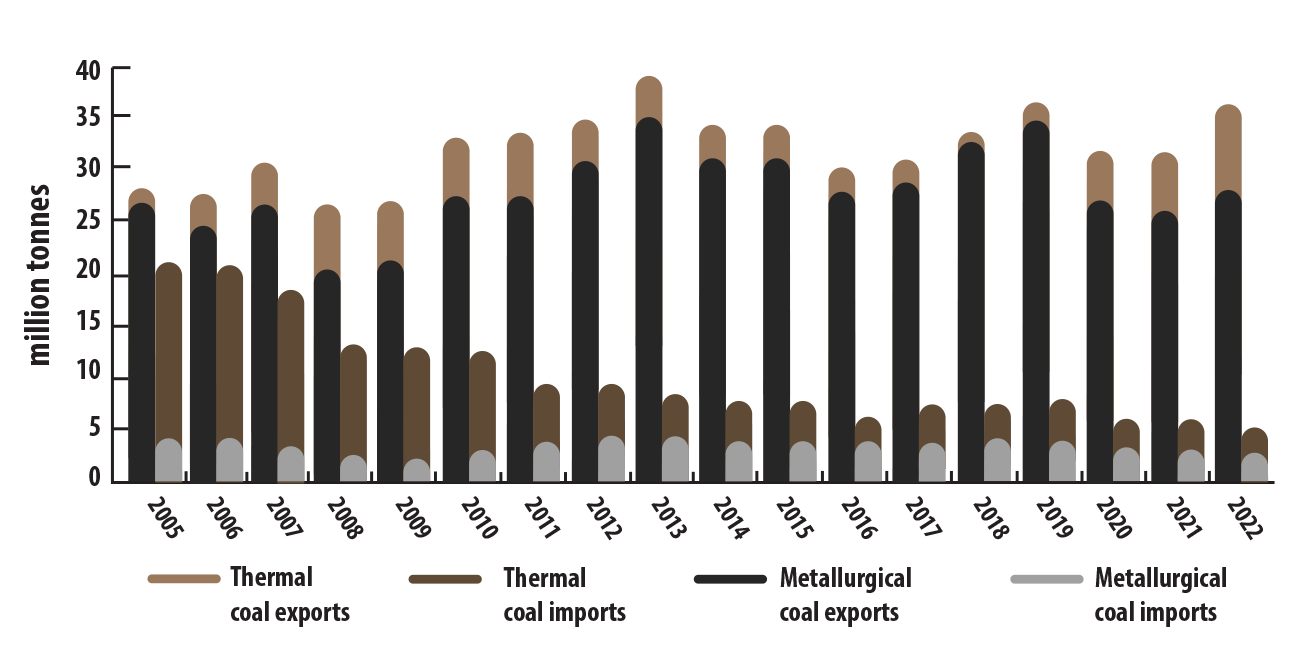
Text version
From 2005 to 2013, coal exports increased from 28 million tonnes to 39 million tonnes before levelling at approximately 30 million tonnes between 2015 and 2017. In 2019, they rose to 37 million tonnes before falling to 32 million tonnes in 2021 and increasing to 36 million tonnes in 2022.
Coal imports decreased from 21 million tonnes to 5 million tonnes between 2005 and 2022.
Metallurgical coal exports decreased from 27 million tonnes to a decade low of 21 million tonnes between 2005 and 2009, but increased to 35 million tonnes in 2013. In 2014, they decreased to 31 million tonnes and fell to 28 million tonnes by 2016. However, the exports started to increase in 2017 and reached 35 million tonnes in 2019. In 2020 and 2021, metallurgical coal exports fell to 27 million and 26 million tonnes, respectively. They increased to 28 million tonnes in 2022.
Thermal coal exports increased from 1.5 million tonnes to 6.0 million tonnes in 2009, remaining stable until 2011. The exports decreased to 4 million tonnes in 2012 and continued to decline to 1 million tonnes in 2018. Between 2019 and 2022, thermal coal exports increased from 1.8 million tonnes to a decade high of 8.3 million tonnes in 2022.
In contrast, metallurgical coal imports remained stable between 2005 and 2022 at an average of 3.6 million tonnes. Thermal coal imports were 17 million tonnes in 2005 but kept declining to a decade low of 2 million tonnes in 2022.
In 2022, Canada exported 36 million tonnes of coal around the world and imported 5 million tonnes, mostly from the United States. Exports to the United States accounted for 4% of Canadian coal exports and represented 28% of total United States coal imports.
Canada's exports are primarily metallurgical coal (77% in 2022).
Canadian exports and imports of coal, 2022
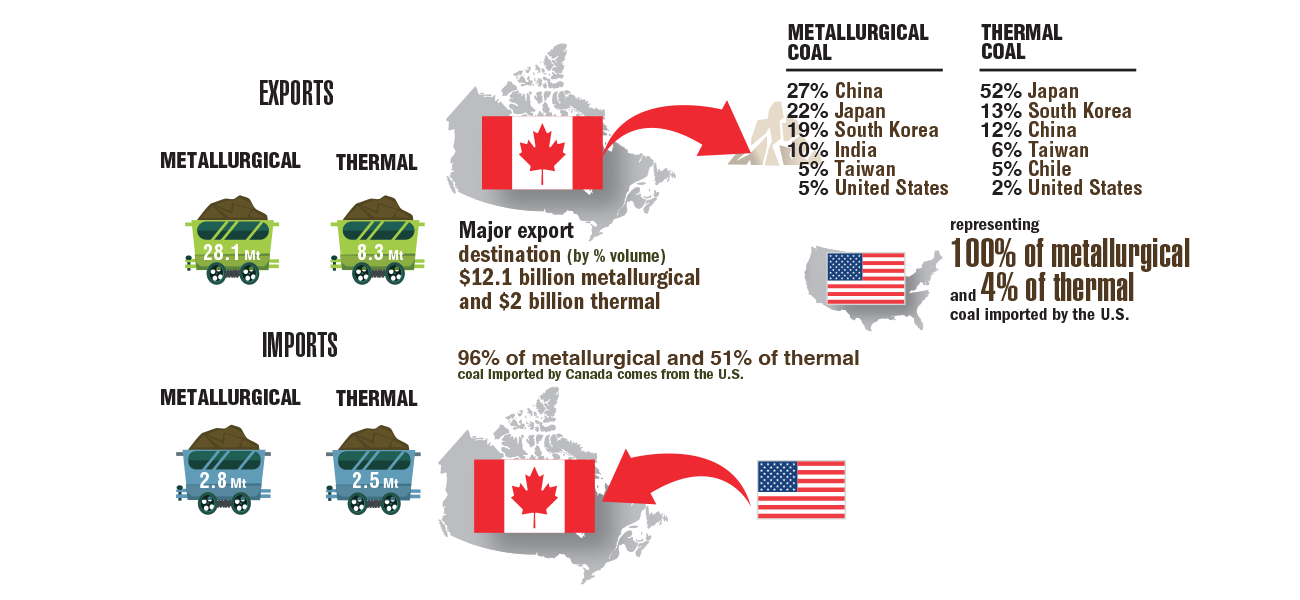
Text version
In 2022, Canadian metallurgical and thermal coal exports were valued at $12 billion and $2 billion, respectively. The major destinations for metallurgical coal exports were China (27%), Japan (22%) and South Korea (19%).
Approximately 5% of Canada's exports of metallurgical coal are to the United States, and Canada is the sole source for that type of coal. In contrast, 2% of Canada’s exports of thermal coal are to the United States, but that is only 4% of the amount that the United States imports.
As for Canadian metallurgical and thermal coal imports, 96% and 51%, respectively, come from the United States. More than half of this imported coal is used for manufacturing steel, the rest is for generating electricity.
 Prices
Prices
In mid-2022, the price of metallurgical coal exported by Canada surged to $554 per tonne, its highest level in the last 10 years. Prices have since decreased but remain at historically high levels. The price of thermal coal exported by Canada followed a similar trend. Coal and other energy commodity prices were heavily affected by the Russian invasion of Ukraine.
Find out more about minerals and metals facts
Notes and sources
Numbers may not add to totals because of rounding.
(p) preliminary
For Canadian coal prices, anthracite is not included.
For Canadian domestic exports and imports, anthracite is included as thermal.
Coal reserves data are for 2020 because that’s the latest data available.
Uses
- Global coal demand, by sector, 2022
Canadian production
- Canadian coal production, 2013–2022(p)
- Statistics Canada Table 25-10-0030-01
- Wood Mackenzie
- Coal production, by province, 2022
- Statistics Canada Table 25-10-0030-01
- Wood Mackenzie
- provincial reports
- Electric power generation from coal, by province, 2021
- Statistics Canada Table 25-10-0084-01
- Coal used for electricity generation, 2021
- Statistics Canada Table 25-10-0017-01
International context
- World production
- International Energy Agency
- Statistics Canada Table 25-10-0030-01
- Wood Mackenzie
- World exports
- World imports
- World proven reserves
Trade
- Canadian coal trade, 2005–2022
- Canadian exports and imports of coal, 2022
- United States imports
Prices
- Prices of exported Canadian coal, 2013–2022
Page details
- Date modified:
